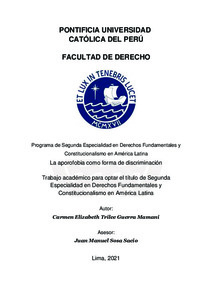| dc.contributor.advisor | Sosa Sacio, Juan Manuel | |
| dc.contributor.author | Guerra Mamani, Carmen Elizabeth Trilce | |
| dc.date.accessioned | 2022-09-05T16:14:33Z | |
| dc.date.available | 2022-09-05T16:14:33Z | |
| dc.date.created | 2021 | |
| dc.date.issued | 2022-09-05 | |
| dc.identifier.uri | http://hdl.handle.net/20.500.12404/23252 | |
| dc.description.abstract | En este trabajo académico, la autora hace un análisis de la aporofobia, término novedoso
acuñado por la filósofa Adela Cortina, la cual es entendida como el rechazo u odio al pobre, a
través de la óptica de la discriminación estructural. En tal sentido, se parte del estudio de lo que
implica el derecho a la no discriminación tanto a nivel nacional como a través de los diversos
instrumentos internacionales, para luego enfocarse en el concepto de discriminación estructural
como fenómeno intergrupal y sistémico.
Además, para comprender mejor el concepto de aporofobia se hace un desarrollo de lo que se
ha venido entendiendo por pobreza tanto a nivel económico, filosófico y doctrinal. De esta
manera, se pasa al análisis teórico de lo que implica la aporofobia y cuáles son sus orígenes,
para vincular este concepto con una forma de discriminación por motivos económicos. Así se
llega a señalar que la aporofobia se manifiesta a través de la discriminación estructural de las
que son victimas diversos grupos a los que se identifica como pobres. Siendo que a los
individuos de estos grupos sociales se les atribuirá diversos estereotipos y prejuicios negativos
que justifican las actitudes aporófobas. Por último, una vez señalado este problema estructural,
se desarrollan algunas propuestas para contrarrestar tal situación en la sociedad peruana. | es_ES |
| dc.description.abstract | In this academic work, the author makes an analysis of aporophobia, a novel term coined by
the philosopher Adela Cortina, which is understood as the rejection or hatred of the poor,
through the perspective of structural discrimination. In this sense, it starts from the study of
what the right to non-discrimination implies both at the national level and through the various
international instruments, to then focus on the concept of structural discrimination as an
intergroup and systemic phenomenon.
In addition, to better understand the concept of aporophobia, development is made of what has
been understood by poverty both at an economic, philosophical and doctrinal level. In this way,
we proceed to the theoretical analysis of what aporophobia implies and decisions are its origins,
to link this concept with a form of discrimination for economic reasons. Thus, it is pointed out
that aporophobia manifests itself through the structural discrimination suffered by various
groups that are identified as poor. Being that the individuals of these social groups will be
attributed various negative stereotypes and prejudices that justify aporophobic attitudes.
Finally, once this structural problem has been pointed out, some proposals are developed to
counteract this situation in Peruvian society. | es_ES |
| dc.language.iso | spa | es_ES |
| dc.publisher | Pontificia Universidad Católica del Perú | |
| dc.rights | info:eu-repo/semantics/closedAccess | es_ES |
| dc.subject | Discriminación--Perú | es_ES |
| dc.subject | Derechos fundamentales--Perú | es_ES |
| dc.subject | Odio | es_ES |
| dc.title | La aporofobia como forma de discriminación | es_ES |
| dc.type | info:eu-repo/semantics/bachelorThesis | es_ES |
| thesis.degree.name | Segunda Especialidad en Derechos Fundamentales y Constitucionalismo en América Latina | es_ES |
| thesis.degree.level | Título Profesional | es_ES |
| thesis.degree.grantor | Pontificia Universidad Católica del Perú. Facultad de Derecho | es_ES |
| thesis.degree.discipline | Derechos Fundamentales y Constitucionalismo en América Latina | es_ES |
| renati.advisor.dni | 40690309 | |
| renati.advisor.orcid | https://orcid.org/0000-0003-1371-1525 | es_ES |
| renati.author.dni | 71559182 | |
| renati.discipline | 421189 | es_ES |
| renati.level | https://purl.org/pe-repo/renati/level#tituloSegundaEspecialidad | es_ES |
| renati.type | https://purl.org/pe-repo/renati/type#trabajoAcademico | es_ES |
| dc.publisher.country | PE | es_ES |
| dc.subject.ocde | https://purl.org/pe-repo/ocde/ford#5.05.01 | es_ES |





